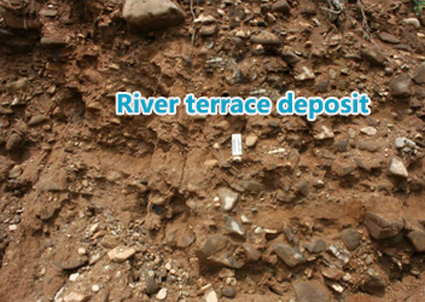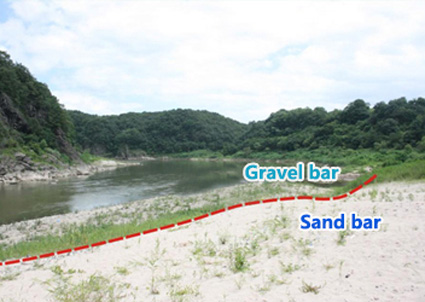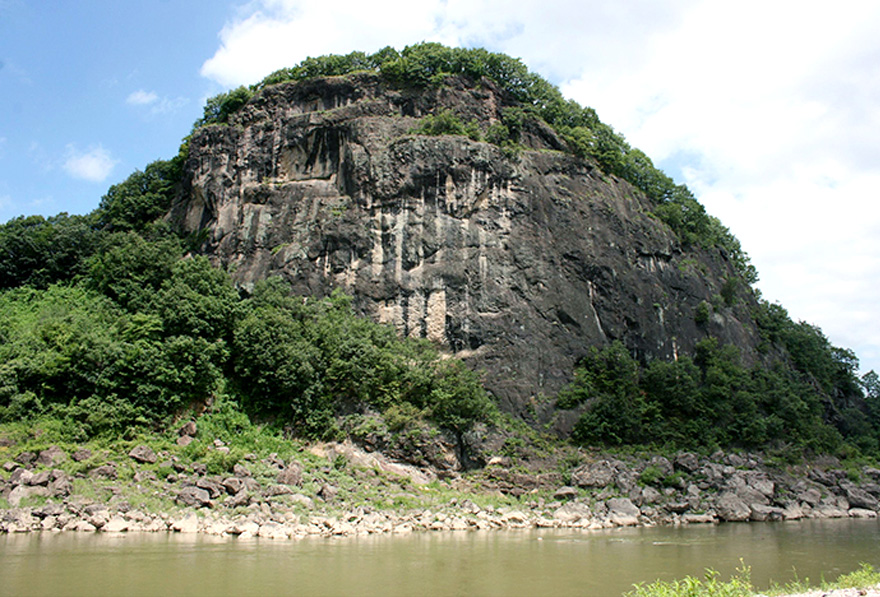Representative
Geosite
Representative
Geosite
Jwasangbawi Rock
- Samtong(Gush-Out Water)
- Soisan Mountain(Cheorwon Lava Land)
- Jiktang Waterfall
- Goseokjeong
- Sambuyeon Falls
- Hwajeogyeon
- Mt. Jijang tuff
- Bidulginang Falls and Meonguri canyon
- Pocheon Auraji pillow lava
- Art Valley and Pocheonseok
- Jaein Falls
- Baekuiri Layer
- Jwasangbowi Rock
- Eundaeri Planticular Joint and Fold Structure
- Jeongokri ruins soil stratum
Jwasangbawi Rock is located in Jangtan-ri, Cheongsan-myeon, Yeoncheon-gun and consisted of Jangtanri basalt belonging to Mesozoic Cretaceous intrusive rocks.
In contrast to the Cenozoic Quaternary basalt forming the flat plain around it, the height from the surface of Hantan River to the peak reaches about 60m, boasting an overwhelming landscape.
-
 Jwasangbawi Rock - River terrace deposit
Jwasangbawi Rock - River terrace deposit
-
 Jwasangbawi Rock - Gravel bar, Sand bar
Jwasangbawi Rock - Gravel bar, Sand bar
. Looking at the geological characteristics of Jwasangbawi Rock Basalt, it has the blocky structure not showing a particular structure and when the volcano erupts, calcium escapes through the holes where air and gas escaped over time and the holes are filled. Since this shape looks like the white kernel of apricot seeds, it is called as the amygdalodal structure and this structure is not seen because creation time is short in Cenozoic Quaternary basalt.
Gravel bar is made in the region where you can see Jwasangbawi Rock and this is a an important place for geological education to observe a variety of rocks in Yeonchun. It is one of the most important places to study rocks because you can see metamorphic rocks, granite, tuff, breccia, gneiss of the sedimentary origin of Misan Layer including Basalt in one place. You can also observe the topographical characteristics because river terrace deposit showing river flowing traces in the past is in the entry of Jwasangbawi Rock.
How old is Jwasangbawi Rock?
There are several methods of measuring the age of a rock and that of Jangtanri basalt was measured by K-Ar whole rock age. According to measurement results, it was reported to be 73.1±1.6 Ma and 94±5 Ma and was interpreted to have erupted in Late Mesozoic Cretaceous. That is, since Cheorwon Basin including Dongmakgol tuff is also known as volcanic rocks of Late Cretaceous, it can be seen that Yeoncheon is an environment where there were violent eruptions in Late Mesozoic Cretaceous
.Origin of Jwasangbawi Rock name
Jwasangbawi Rock has been called by many names for a long time. Seonbong Rock because it is a rock where Taoist hermits wandered, Pulmusan because it looks like bellows or people blew with the bellows there, Jwasal Rock because it looks like a sitting monk, Suicide Rock because many people fell and died during the Korean War...However, Jwasangbawi Rock is called more often than any other name in Cheongsan-myeon where Jwasangbawi Rock is currently located. Jangseung (Korean traditional totem pole at the village entrance) that has defended Cheongsan-myeon, Jwasangbawi Rock is considered as the patron saint of Gungpyeongri Village. Jwasang is derived from the meaning of the great shape on the left side of Gungpyeongri Village.
